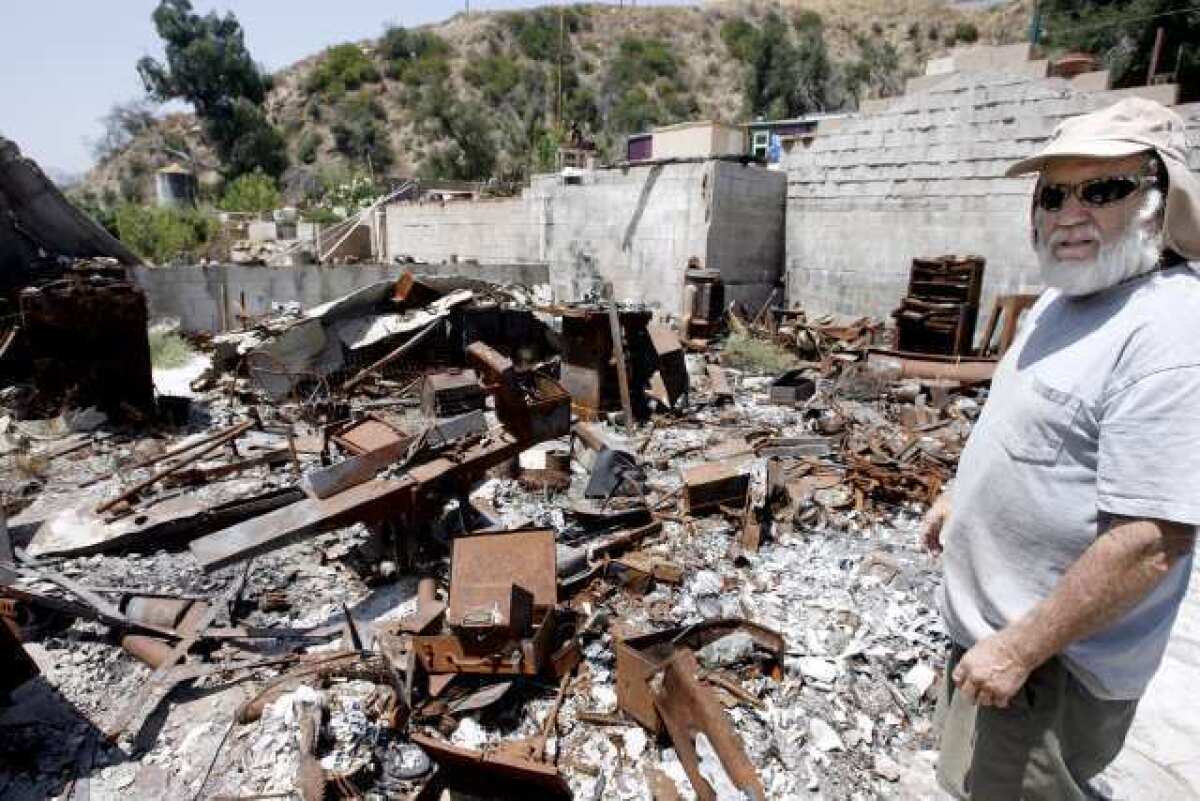Three years later, rebuilds grind on

The matching 7,500-gallon water tanks resemble silos, looming conspicuously over Stoneyvale Road in this once-heavily-wooded enclave in Big Tujunga Canyon.
Their presence signals traction in a rebuilding process that began shortly after the Station fire ripped through Angeles National Forest three years ago, destroying more than 80 homes and killing two firefighters.
But for Stoneyvale “permittees” who own cabins on national forest land — some of them quip about renaming the road “Tin Can Alley” — the water tanks represent a saga of miscommunication and mismatched expectations with Los Angeles County officials that they say have slowed an already painful recovery.
“The Fire Department has changed what they want our water tanks to be three different times,” said Christopher Gould, who with his grandfather has managed to erect the only post-fire house in the neighborhood. “It is just so ridiculous. We stopped asking, at a point.”
Stoneyvale is remote yet accessible, situated just off Big Tujunga Canyon Road eight miles deep into Angeles National Forest. Before the fire, there were roughly two dozen rustic homes, many dating back to the 1930s and ‘40s.
“We went home to a place that most people would vacation to go to,” said Bert Voorhees, an attorney who lost his home during the Station fire.
Those same features are what have complicated the rebuilding process, said officials in Los Angeles County Supervisor Mike Antonovich’s office. Many of the destroyed Stoneyvale homes predated current building and safety codes. And the off-the-radar locale meant that there wasn’t vigorous code enforcement of newer construction.
At some spots, the road ran over several feet of private property, and in other spots private property demarcations fell on the county road.
In short, what was on the books at the Los Angeles County assessor’s office wasn’t necessarily what was on the ground in Stoneyvale at the time of the fire.
After the blaze, county officials set about surveying the neighborhood — a job that was near the top of a long to-do list that included addressing the community’s water system, septic tanks, flood risk, emergency vehicle access, setbacks and wall heights.
“If you are going to rebuild, it totally makes sense to build to current building and fire code,” said Paul Novak, who worked extensively with the Stoneyvale community as a former planning deputy in Antonovich’s office. “That is something you would do with any house anywhere. If you are going to build it, build it to today’s standards.”
The county hosted a series of meetings to facilitate the rebuilding process and draft a set of development guidelines specific to the street. Three years later, the kinks have been largely worked out, county officials said.
“I think some of what they went through was typical,” Novak said. “Some of it was a little bit worse because of where their homes were. This is a remote area without a lot of facilities and services.”
But for permittees — some are living in rentals in nearby La Crescenta and La Cañada Flintridge — it has proven to be a bitter postscript to the Station fire.
They describe a bureaucratic minefield that has included shifting directives from county officials, multiple iterations of building plans and thousands of dollars spent on permits and fees.
“There were so many meetings with [officials] who didn’t know what they needed to know,” said Rob Driscoll, who bought his Stoneyvale cabin in 1997. “If an individual business owner showed up like that, they wouldn’t have any customers.”
Several neighbors have given up.
“Things worked,” said John Benriter of his former forest hideaway that he bought in 1980. He lost that home, his motorcycles and cats to the fire. “But now they want us to be a nice little subdivision laid out in the precision of a cemetery, and that is basically what we are.”
Among the final points of contention was the minimum of 12,000 gallons of water the Los Angeles County Fire Department wants on each parcel, to be used in case of a fire.
Permittees said their objections are both practical and aesthetic. They argue the tanks are unsightly, and if every homeowner has them, there will be enough water to wash the whole neighborhood down the canyon.
But county Deputy Fire Chief John Todd, who heads the Fire Department’s prevention bureau, said the water requirement is based on a specific formula of the number of gallons per minute needed to fight a fire.
Fire codes are growing increasingly stringent, which can complicate rebuilds for homeowners, but with good reason, he added.
“We are trying to modernize things,” Todd said. “We are trying to stay ahead of things. We are trying to make sure [the] home doesn’t burn down again. I have been on sites before where homes have burned down twice.”
The finish line may be in sight. Driscoll says he expects county officials to give final approval on his plans this fall. He plans to have his new home framed by January.
Others said they will follow his lead.
More than anything, they look forward to becoming a neighborhood again.
“It if were just me I would have given up,” Voorhees said. “But there were a bunch of folks I used to live with who [made up] my neighborhood. Some of them I got to know much better after the fact.”
---
Follow Megan O’Neil on Twitter